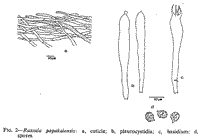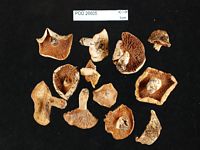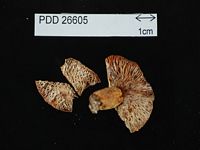|
 Russula papakaiensis Russula papakaiensis
BiostatusPresent in region - Indigenous. Endemic
Images (click to enlarge) | 
Caption: Dried type specimen
Owner: Herb PDD | 
Caption: Dried type specimen
Owner: Herb PDD |
Article: McNabb, R.F.R. (1973). Russulaceae of New Zealand. 2. Russula Pers. ex S.F. Gray. New Zealand Journal of Botany 11(4): 673-730 (http://www.rsnz.org/publish/abstracts.php).
Description: pileus: 3.5-7 cm diam., convex when young, centrally depressed at maturity, slightly viscid under wet conditions, otherwise dry, glabrous, finely felted under lens, velar remnants absent, white when first emerging from soil, darkening to cream or creamy ochraceous, often stained with yellowish brown areas: margins entire, thick, non-pectinate. Cuticle 150-200 µm thick, composed of ± repent, interwoven hyphae and pilocystidia; hyphae thin-walled, septate, 2.5-5 µm diam., terminal cells unspecialised: pilocystidia sparse, ± cylindrical, thin-walled, apices rounded, acuminate, or capitulate, contents refractive in KOH, of variable length, 3.5-5.5 µm diam. lamellae: adnexed to adnate, crowded, moderately thick, simple, or rarely forked near stipe, to 4 mm deep, pallid creamy white, early heavily discoloured with dull brown spots, lamellulae numerous, typically in partial sequence. stipe: 1.5-2.5 cm long ± equal, 1-1.8 cm diam., stout, solid, dry, glabrous, finely felted under lens, white; flesh white, unchanging on exposure to air. Cuticle similar to that of pileus; caulocystidia similar to pilocystidia. spores: spore print creamy white; spores broadly elliptical, obliquely apiculate, apiculus to 1.5 µm long, 6.5-8 X 5.5-7µm, ornamentation rather sparse, of amyloid verrucae of irregular size and shape, to 0.7 µm high, isolated or joined by fine amyloid ridges and forming a partial reticulum, occasionally a few adjacent verrucae joined by moderately coarse amyloid ridges; plage indistinct. hymenium: basidia hyaline, clavate, 46-63 X 7-9.5 µm, 4-spored, sterigmata to 9 µm long; pleurocystidia scattered, numerous, subclavate to fusiform, hyaline, thin-walled, contents refractive in KOH, not or only slightly projecting beyond basidia, apices bluntly acuminate, occasionally mucronate, strangulate, or capitulate, 50-70 X 5.5-8.5 µm, cheilocystidia numerous, similar to pleurocystidia but shorter. hymenophoral trama: heteromerous, intermixed. context of pileus: white, firm, unchanging; structure heteromerous, clamp connections absent. taste: lamellae acrid, context slightly acrid. chemical characters: Formalin on context—n.r.; phenol on context—slowly deep vinaceous: FeSO4 on context—pallid salmon pink; guaiacol on stipe base—rapidly pink, darkening to pinkish red; KOH on pileus—darkening on coloured areas; on context—n.r.; NH4OH on pileus and context —n.r.
Habitat: Gregarious under Leptospermum
Notes: Russula papakaiensis is characterised by the dull brown spotted lamella, small spores with ornamentation to 0.7 µm high, pleurocystidia not projecting beyond the level of the basidia and the acrid taste of the lamella.
It appears to belong to the section Compactae Fr. subsection Plorantes Bat. of Singer (1962), or in the subsection Lactarioideae Maire of Shaffer (1964)
|